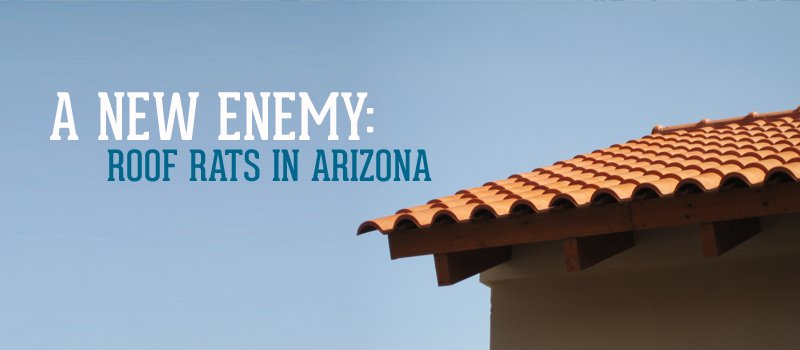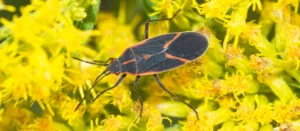$50 OFF New Residential Customers. Learn more
A New Enemy: Roof Rats in Arizona

For Rattus rattus, the scientific name for what we call roof rats, Arizona is now home. Also known as the black rat, this rodent poses a plague of hazards, including the plague. According to the University of Arizona, aside from disease transmission, roof rats eat and contaminate food, chew on household wiring, and tear up home insulation. Outside the home, they eat plants, tree bark and fruits.
Phoenix, Arizona – Ground Zero
First appearing in Phoenix in 2001, roof rats are relatively new to Arizona. They’re also not even native to North America, as they traveled on ships from Europe hundreds of years ago. In recent years, they again likely hitched a ride, arriving in Arizona by way of freight shipments.
They adjusted well to the southwestern climate, which seems near perfect for roof rats. Phoenix, with its irrigation canals, and palm and citrus trees, has made a great home for these pesky rodents.
Mesa, Arizona Deals with a New Pest
Rat sighting reports tend to worry people — and with good reason. These rodents show up on power lines, in trees and bushes, and even on porches and patios. From Glendale to Mesa, and Chandler to Scottsdale, Arizona, roof rats have people concerned about not only property damage, but also health risks.
Fortunately, according to Maricopa County Vector Control, periodic testing results have thus far been negative for tularemia, Hantavirus, and plague in area roof rats. In case of any health risks, though, Chandler, Arizona, as well as Mesa and other surrounding municipalities, refer residents to the county vector control office for help and guidance.
Properly identifying a rat
In some respects, a rat is a rat, period. Correct identification of the rodent in your home increases the chances of eradicating this pest.
Few truly want to spend a lot of time closely observing a rat’s physical characteristics and behavior, so it pays to know what to look for in identifying a rodent. According to the University of Arizona, physical characteristics of rats include:
- A combined head and body length of seven to eight inches.
- A tail longer than the length of their head and body, usually about eight to 10 inches long.
- The tail is scaly and hairless.
- Large, almost hairless ears.
- Usually blackish body fur, with a lighter belly.
- Pointy nose.
Signs and Signals of Roof Rat Infestation
These rodents like heights. Rats are great climbers, so they easily access treetops as well as roofs. Their nests generally appear in rafters, soffits, and other high locations, although in warmer locales, they sometimes create ground burrows.
According to the University of Arizona, some of the signs of root rats are:
- Smudge marks around higher areas of a structure, caused by the dirt and oil of their fur
- Scurrying sounds in the attic at night (roof rats are nocturnal creatures)
- Nervous or excited pets
- Discovery of a sizable food stash
Another telltale sign of a roof rat is hollowed out citrus fruits, where the rats leave nothing but the rind and/or skin.
Steps for Preventing Roof Rat Infestation
An ounce of prevention is worth a pound of cure, and in the case of roof rats, it is especially true. Here are some steps you can take to proactively keep rats away from your home:
- Deprive rats of any food resources, including keeping garbage contained and properly storing food (this includes pet food).
- Eliminate any water sources.
- Keep landscaping trimmed, roof rats like to hide in ground cover.
- Remove vines and overhanging tree branches on which rats might climb.
- Remove ripe fruit from trees promptly.
- Secure pet doors.
- Seal pipe and wire entry holes using copper, wool, mortar, or flashing.
- Cover vents with wire mesh.
- Install sheet metal rat guards at least 18” to 24” in width on trees and walls.
Roof rats are enterprising creatures, so take these extra steps to make it difficult for them to enter your house.
Eradicating Rats
In many cases, controlling rats requires trapping and poisoning. However, few people want to deal with that process. Traps are an option. Poison also works, but is not the best choice for indoor use, as the rat may die and stink up your home as it decomposes.
For many, the best option is hiring a professional to come in, assess the situation, place the proper bait and traps, and, thankfully, dispose of the results.
Related Posts

Killer Bees in Arizona? Understanding Africanized Bees and How to Coexist Safely
You’ve likely heard the term “killer bees” used to describe Africanized bees in Arizona, but did you know this nickname…

Red & Black Intruders: Meet Arizona’s Boxelder Bugs
Boxelder Bugs in Arizona If you’ve ever stepped outside and spotted a cluster of black-and-red bugs crawling on your porch…

Jumping Spiders in Arizona: Harmless or Hazardous?
Jumping spiders in Arizona might be small, but they can sure give you a big surprise when they suddenly appear…